#potoos and frogmouths are not in this one
Explore tagged Tumblr posts
Text
Round 3 - Reptilia - Caprimulgiformes
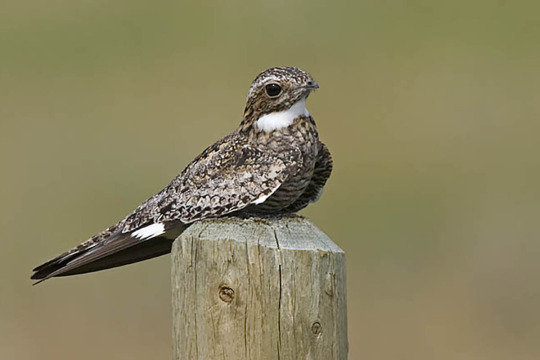

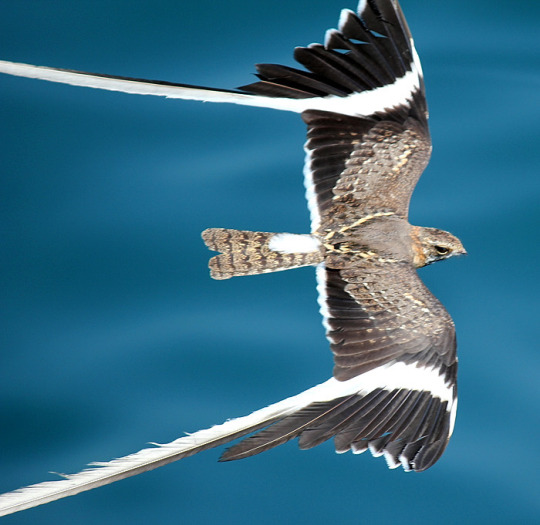

(Sources - 1, 2, 3, 4)
As we move into the Strisores clade, our next order are the Caprimulgiformes, commonly known as “nightjars”, “bugeaters”, or “nighthawks”. Caprimulgiformes is composed on one family, Caprimulgidae, and 19 genera.
Nightjars are medium-sized nocturnal or crepuscular birds, characterised by long pointed wings, short legs with small feet, and short beaks at the tip of a large mouth. Their primary source of food are night-flying insects, and they fill a similar role to insect-eating bats. Nightjars usually catch their prey by flying through insects with their wide mouths open. They have soft, cryptic plumage, allowing them to camouflage against trees while they sleep during the days. They have rictal bristles around their beak which function similarly to whiskers. Nightjars live on all continents except Antarctica, and some islands, in almost all habitats aside from the most arid deserts.
Nightjars are generally solitary, but will form flocks for the purpose of migration and/or for mating displays. They usually nest on the ground, laying one or two patterned eggs directly onto bare ground. It has been suggested and quoted that nightjars can move their eggs and chicks from the nesting site in the event of danger by carrying them in their mouths, but there is little evidence to support this idea. The nocturnal and secretive nature of nightjars makes it hard to study their behavior. It is unknown whether nightjars mate for life, but they are monogamous for the duration of the mating season.
Strisores have a well-represented fossil record, with fossils of most major strisorean lineages known from the Paleogene. Strisores evolved in the Eocene, with its two main extant lineages separating about 60–55 million years ago. At around 40 mya, the common ancestors of Caprimulgidae and Nyctibiidae diverged from those of the oilbird and frogmouths.

Propaganda under the cut:
The Common Poorwill (Phalaenoptilus nuttallii) is one of the only birds that undergoes a form of hibernation, becoming torpid and with a much reduced body temperature for weeks or months. Other nightjars can also enter a state of torpor, but for shorter periods.
The European Nightjar (Caprimulgus europaeus) is also known as the Common Goatsucker. This, along with their genus name, refers to an old myth that it would suckle from goats at night, causing them to cease to give milk. (Nightjars do not do this)
Nightjars have a reflective tapetum lucidum at the back of their eyes, causing their eyes to “glow” when lit up at night.
Nightjars do almost everything on the wing, including eating and drinking.
Several comic book heroes use the pseudonym “nighthawk”, including the detective Nelson Lee in “The Nelson Lee Library”, a Harvey Comics superhero, the cowboy Hannibal Hawkes in the DC Comics Universe, and several characters within the Marvel Comics Universe. In fact, there is an abundance of media using the name “nighthawk”, from art pieces, to films, to music, to sports teams, to racehorses, to aircraft, motorcycles, firearms, and amusement park rides. It’s possible that many of the people using this name only know that the nighthawk is a nocturnal bird, and not so much that it’s a small, big-mouthed, insect-eater.
#please note that these are just nightjars and the other strisores have their own orders#potoos and frogmouths are not in this one#also sorry there’s not as much propaganda as I would have liked but I gotta sleep#animal polls#round 3#reptilia#Caprimulgiformes
94 notes
·
View notes
Text
I love you Potoo I love you great Potoo I love you Potoo I love you great Potoo I love you Potoo I love you great Potoo I love you Potoo I love you great Potoo I love you Potoo I love you great Potoo I love you Potoo I love you great Potoo I love you Potoo I love you great Potoo I love you Potoo I love you great Potoo I love you Potoo I love you great Potoo I love you Potoo I love you great Potoo I love you Potoo I love you great Potoo I love you Potoo I love you great Potoo
#oni talks#thoughts#context: based my current dnds current familiar on the Potoo & had a session today that reminded me how much I love potoos#Also important context the Potoo was doing a dragons breath moment but acid which is just so fun to imagine#I have a bunch of birds I’d put in fantasy versions of as my familiar if they ever go down coz I just really like birds & find familiar is#basically asking for bird time!! like nightjars & frogmouths!! ALSO my current familiar is the common Potoo & depending on what happens I#like to think towards the end of the campaign it will be a great Potoo (probably with other bird types in between)#other option is a Harpy eagle coz that feels pretty fitting? OR there’s a few different vampire themed birds that would fit so good#for any DnD fans context is we’re playing curse of strahd & ofc for the one break we did for a one shot I just played a kenku (bird ppl)#He’s a cha I had for a long time who is named after a sound cats make so he’s a lil bird guy making cat sounds & also his most recent#iteration is as a drag queen who danced so good (as birds so often do) the party didn’t die (he’s a dance bard) I love birds so much#also making fantasy animals based on irl animals is so fun even if it’s basically just a color/aesthetic swap#OH ALSO Owlet-Nightjars are so pretty! tbh I’m surprised I haven’t had more bird characters at this point it’s only the kenku#& also this aarakocra (?) I made once for an art prompt but have yet to play I wanna say he was a paladin but I’d have to check he was based#on like the sun and also stained glass & also kinda how baby eagles look just meant to be white & gold & fluffy#I wish more casters naturally got find familiar if I could I would probably give every character a themed familiar
4 notes
·
View notes
Note
So watching a science/biology youtuber yesterday (if i recall correctly he's an evolutionary biologist) I learned that one of the relatives of hummingbirds, (and this is exactly how the scientist describes them) look like muppets and many would think their photos are ai. So- your thoughts on birds that look like muppets?
Muppets - Hummingbird Relatives
So I'm not sure what the youtuber is talking about. The closest relatives of hummingbirds are Swifts and Treeswifts, but I suppose if you go up a level they are also a little more distantly related to nightjars, oildbirds, owlet nightjars, nightjars, potoos, and frogmouths.
family Trochilidae - order Apodiformes - (undefined clade) Strisores
Im not sure which relative looks like a muppet to this person, but i do agree that many members of the Strisores look like muppets.
I mean... I'm don for muppet ass lookin birds.

Spine-tailed Swift aka White-throated Needletail (Hirundapus caudacutus), family Apodidae, order Apodiformes, Australia
Resident (year round) in the Himalyas
Breeding in East Asia
Wintering in Australia
photograph by British Trust for Ornithology

Whiskered Treeswift (Hemiprocne comata), parent sitting on egg, family Hemiprocnidae, order Apoformes, found in SE Asia
photograph by DM

Blyth’s Frogmouth (Batrachostomus affinis), family Podargidae, order Podargiformes, Perlis, Malaysia
The frogmouths used to be included in the Nightjar/Goatsucker order Caprimulgiformes, but as of 2019, are now in their own order. They are not as closely related to nightjars, as previously thought.
photograph by Junaidi Ismail

Northern Potoo (Nyctibius jamaicensis ), mother and chick, family Nyctibiidae, order Nyctybiiformes, Costa Rica
Potoos used to be in the same order as nightjars, but are now placed in their own order.
photograph by Alvaro Cubero
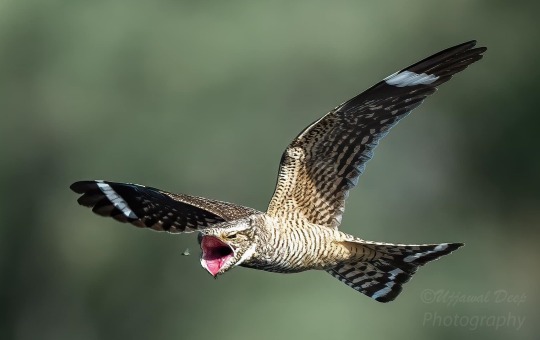
Lesser Nighthawk (Chordeiles acutipennis), EAT UP A TASTY BUG!!!, family Caprimulgidae, order Caprimulgiformes, Salt River, AZ, USA
photograph by Deep Ujjawal
270 notes
·
View notes
Text
Great Backyard Bird Off - the Americas (poll 6)


Bird Info & Submission Reasons
Common Potoo (Nyctibius griseus)
"My favorite bird! Saw one at the zoo when i was 6 years and got nightmares for weeks. Then found one in the yard of my college dorm, got rescued by the firemen, lovely stump of wet eyes and haunting singing, it has a legend in guarani-tupi mythology. Related to nightjars frogmouths. i think." [just related to nightjars]
Hoatzin (Opisthocomus hoazin)
"It’s one of my favorite birds. Unique evolutionary lineage, digests leaves like a ruminant, has wing claws as juveniles. And I recently got to see one when on vacation!"
Image Sources: potoo (Leo Weiskittel), hoatzin (Rhys Marsh)
#Great Backyard Bird Off#bird poll#animal poll#american birds#central american birds#south american birds#common potoo#hoatzin
130 notes
·
View notes
Text
Palestine Sunbird
The end of the ceasefire is heartbreaking but sadly not unexpected. I am still uploading Palestine designs regularly, ALL PROCEEDS will continue to go to my Palestinian best friend to help his loved ones through this war. He is the sweetest person in the world (and a truly brilliant scientist) and he deserves so much better than this. All designs found here.
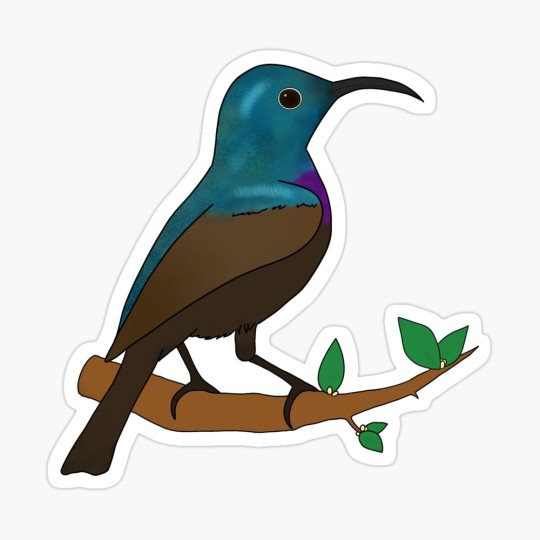

The Palestine sunbird is a beautiful little passerine found around parts of the Middle East and Africa. They look somewhat like giant hummingbirds (though that is entirely convergent evolution, hummingbirds are actually in the same clade (Strisores) as potoos and frogmouths and stuff which is wild to me). These little guys were adopted as Palestine's national bird in 2015. My drawing is available on shirts, stickers, mugs and more.
...and I'm just realizing right after I posted this that the work isn't showing up right now since I tweaked the title in my shop. Hopefully it will be back promptly, until then my Redbubble has plenty of other designs to support my friend including a couple doves with keffiyehs. Sorry, Redbubble is a little neurotic about checking art with "controversial" keywords.
Edit: okay he's back
#palestine#free palestine#gaza#free gaza#save palestine#colonialism#decolonize#فلسطين#social justice#human rights#palestine sunbird#sunbird#ornithology#birdblr#birds#ceasefire#redbubble
863 notes
·
View notes
Text
Adding to the previous bit of me and my fiancé’s slay the princess au/ head cannon. Here are the different birds and their voices:
Voice of the Hero- Eagle. High on the food chain; a common symbol of strength
Voice of the Smitten- Peacock. Focused on preening and their appearance; a symbol of beauty, love, and elegance
Voice of the Hunted- Sparrow. Small and pretty low on the food chain; rarely predator, mostly prey
Voice of the Broken- Chicken/ Turkey. Commonly farmed in terrible conditions; sad and is used to seeing the worst in a situation
Voice of the Cold- Shrike/ fire hawk. Both known for their violent hunting tendencies; ready to kill
Voice of the Cheated- Cockatoo. I just thought this one was funny. Voice of the Opportunist- Seagull/ Pelican. Will take anything given the chance; always looking for a way to have a situation fall in their favor
Voice of the Contrarian- Cockatiel. Once again, just thought it was funny.
Voice of the Stubborn- Pigeon/ Seagull/ Bluejay. That’s just their whole personality
Voice of the Paranoid- Hummingbird. Quick birds that are skittish Voice of the Skeptic- Potoo/ Frogmouth. I just really wanted one in this head cannon.
400 notes
·
View notes
Text
Get to know your mutuals!
Tagged by @kanskje-kaffe ! Thank youuu
What's the origin of your blog title?
Well. Woohee, so when I was in junior high or so, me and one of my friends made a dog comic/ OCs (Because of course, Ginga and all that). I really liked one of the side characters name and it translated to Wishing Urn. It...It was a whole thing. SO I started using variations of that as my name online. Now it's simply Wish and I just come up with names that have wish in 'em in some way to make it "mine".
OTP(s)+ shipnames(s):
Vander x Silco (zaundads) Oz x Ed (Nygmobblepot) Absolute wild cards: Ignis x Cladio Archie x Maxie (I just remembered them because I am playing pokemon ruby atm)
Favourite color:
Yellowish orange (gold-ish), bluish grey, pale blue
Song stuck in your head:
Shut Up and Dance by Walk the Moon. It's one of those cheesy songs I have given to my OC's (LM and LZ) so yea, its now in my head.
Weirdest habit/trait:
I love square things. But only specific kind. And I love how they feel, especially if they're chocolate bars. If the wrapping is made out of paper, it's heaven. I....can't explain this. I found a case to hold my jewelry and it's just nice, square and the fabric is great. I love it.
I don't collect them or anything. I just love having the little moment of "oh this is nice" whenever I found things like that
Hobbies:
Videogames, art, knitting, crocheting (rarely but a times), needle felting, reading...
If you work, what's your profession?
I have studied a lot, no job
If you could have any job you wish, what would it be?
I guess it would be a comic artist or well, hmm. Dunno, I would like to own a cafe or something that I could try to make a haven for people that need work but the capitalist work environment is not good for them. Them is me. I want that kind of place.
Something you're good at:
Adapting
Something you hate:
I will repeat @kanskje-kaffe and say purity culture. It's getting out of hands, guys.
Passive-aggressiveness. Cowards do this (media is different, we can enjoy it in media)
Something you collect:
Well, I used to collect stickers and sketchbooks.
Something you forget:
Everything. I have ADHD
What's your love language:
I wish I knew
Favourite movie/show:
My holy trinity: Hot Fuzz, Peking Opera Blues, Young Frankenstein.
Other mentions: The Mummy, Child's Play/Chucky Movies, The Road to El Dorado
For the shows: The Invisible Man (my feel good show), Ghosts (BBC)
((I have a lot more but can't think of anything atm))
Favourite food:
I do love beef. I guess. Hmm. I am a pastry lover, too.
Favourite animal:
Dogs, of course. Also, frogmouths/potoo.
BEARS!!!!!!!!!
What were you like as a child:
Not liked? And shy. I guess I acted on my adhd a lot more freely then. And I did not engage in petty drama in high school. People did not like that I didn't take sides.
Favourite subject at school:
History and art.
Least favourite subject:
Math and Swedish. I suck at math and we had the worst swedish teachers so
What's your best character trait?
If something has to be done, I will get it done. Like, I have social anxiety but I will be the one in the friend group to step up and be the most social if needed. I will adapt.
What's your worst character trait?
I am a good liar when it comes to myself, I guess. Your comfort is far more important than my current mental state. My parents don't even know I have like three diagnoses.
If you could change any detail of your life right now, what would it be?
I just want to do something meaningful
I'll tag @withercrown @teawithghosts
38 notes
·
View notes
Text

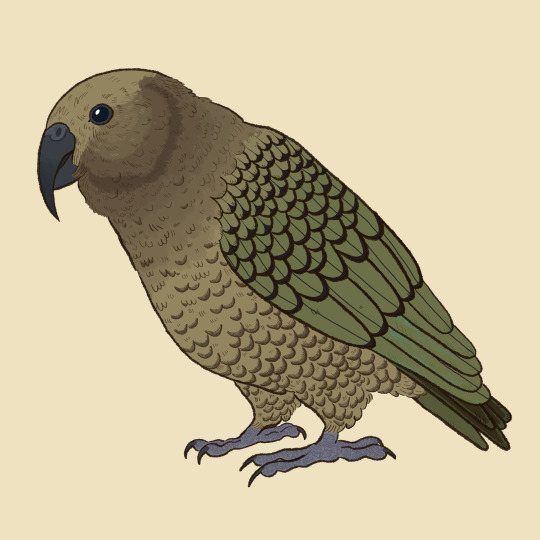
Remember to read about the contestants before voting!
Potoo
Ah, the Potoo. A little guy with a big personality, their huge eyes have often made them the subject of memes. But look past the memes and you’ll see an interesting little fellow. They are similar to the tawny frogmouth, even related to them, as they have a large mouth for catching insects. Unlike the frogmouth, however, they will pounce on prey (which is usually insects), taking it back to their perch to eat it. They are sometimes known to also eat birds and bats. Learn More!
Kea
The worlds only living alpine parrot, the Kea bird is a rambunctious, mischievous scamp! Native to New Zealand, they are often a nuisance to people visiting the mountains, as they will pick at the rubber parts of cars. They have also been shown to be very playful with one another, and what’s closely related to playing? Intelligence! They are also a very intelligent bird, observing and calculating the best way to get food. They are, sadly, endangered. Learn More! Comedy! Longer!
(Art by @tertain-the-original )
496 notes
·
View notes
Text
Fluvioviridavis michaeldanielsi Mayr & Kitchener, 2024 (new species)

(Type specimen of Fluvioviridavis michaeldanielsi [scale bar = 5 mm], from Mayr and Kitchener, 2024)
Meaning of name: michaeldanielsi = for Michael Daniels [collector of the original fossil]
Age: Eocene (Ypresian), 54.6‒55 million years ago
Where found: London Clay Formation, Essex, U.K.
How much is known: Partial skeleton of one individual, including parts of the skull and some forelimb bones.
Notes: F. michaeldanielsi was a member of Strisores, a group of birds that includes hummingbirds, swifts, and nightjars, among others. It is unclear which extant strisoreans it was most closely related to, but it most closely resembles frogmouths in terms of its beak shape.
Two other species of Fluvioviridavis are currently recognized: F. platyrhamphus from the Eocene of the western United States, and F. nazensis, another newly named species from the London Clay Formation. F. michaeldanielsi was smaller than F. platyrhamphus and differs from F. nazensis in details of its wing and shoulder bones.
Reference: Mayr, G. and A.C. Kitchener. 2024. The non-apodiform Strisores (potoos, nightjars and allied birds) from the early Eocene London Clay of Walton-on-the-Naze. Palaeobiodiversity and Palaeoenvironments advance online publication. doi: 10.1007/s12549-024-00610-9
#Palaeoblr#Birblr#Dinosaurs#Birds#Fluvioviridavis michaeldanielsi#Eocene#Europe#Strisores#2024#Extinct
36 notes
·
View notes
Text
Fossil Novembirb 11: A New Dawn

Palaeotis by @drawingwithdinosaurs
One of the absolutely best known ecosystems of the Eocene is found at the Messel Pit site of Germany. Deposited in a similar way (via multiple volcanic eruptions over periods of thousands of years) to the Fossil Lake of yesterday, but a few million years later, it shows the end of the early Eocene and the start of the emergence of modern mammalian groups. Lucky for us, it also shows the next stage of bird evolution! This was also the site featured in the first episode of Walking With Beasts, "A New Dawn", though the avifauna was not particularly well represented in that program.
Yes, obviously, Gastornis was in Messel, though as a large ground herbivore than a predator. But there were plenty more birds than that! Lithornis was also here, because it was just as ubiquitous; and there was also the mysterious Palaeoganth Palaeotis. Originally thought to be a relative of Ostriches, then not, and now possibly again, this bird has a strangely intermediate morphology between that of large flightless Palaeognaths and the Lithornithids of the early Paleogene; indicating it may be a transitional form. It would not have been able to fly, given its short wings and lack of keel, and probably fed on small animals in its environment.

Juncitarsus by @thewoodparable
In addition to the Megafowl Gastornis, there was also the early landfowl Paraortygoides, which did not have a crop like living landfowl and as such probably mainly fed on soft plant material. It also had shorter legs than other landfowl relatives at the time, indicating it may have been more similar to living pheasants than fowl that had been around previously.
Even though the Flamingo-Ducks like Presbyornis would stick around well into the Neogene, the first relatives of Flamingos show up at around this time. Juncitarsus was a wading bird, probably just as closely related to living grebes as their cousins flamingos, and had gastroliths in its stomach - allowing it to feed on hard animals it gathered in from the lake. It wasn't the only wader; Messelornis, a wader related to living rails and cranes; is the most common bird at the Messel Pit and was an important generalist in its ecosystem. In addition, the "Snipe-Rail" Rhynchaeites was actually an ibis relative, probing for food with its beak in the substrate around the lake.
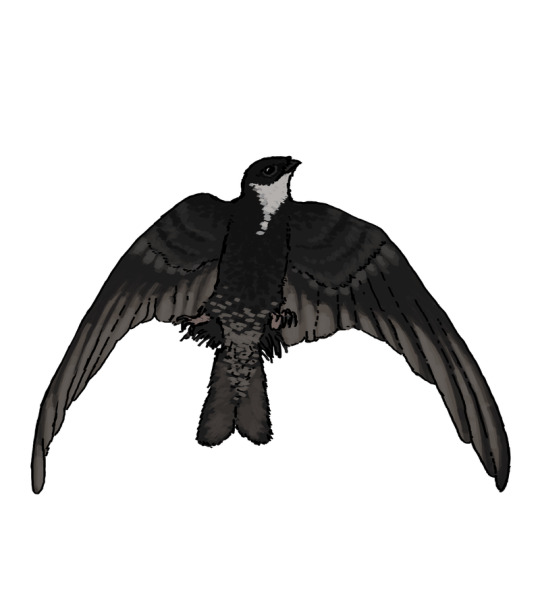
Scaniacypselus by Paleo Miguel
Strisores are everywhere at Messel, with relatives of swifts and hummingbirds like Cypseloramphus, Parargornis, and Scaniacypselus, which weren't as adapted to specialized aerial niches as their living relatives. An insectivore with tiny feet, Protocypselomorphus, was also present; as were an early potoo in the form of Paraprefica and an early frogmouth in the form of Masillapodargus.
Strange flight specialists far away from their living ranges aren't the only bizarre features of the ecosystem - Masillastega, a piscivore and relative of living gannets and boobies, was also present at Messel. More relatives of seriemas, like Dynamopterus, Salmila, and Strigogyps showcase how not all Cariamiformes were predators - Strigogyps was an herbivore! The long-legged predator Masillaraptor was present there too, indicating falcons were successful as multiple types of raptors prior to today. The owl Palaeoglaux was a small predatory bird, with ribbon-like feathers in dense layers on its back.
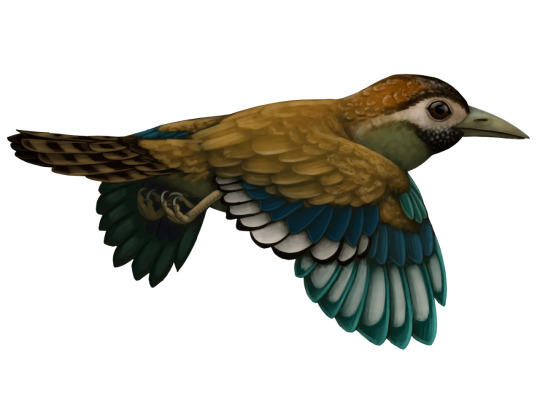
Eocoracias by @drawingwithdinosaurs
There were, of course, many tree dwelling birds in this lacustrine forest, including relatives from both sides of the "core landbirds" family tree. The ecosystem preserves a truly alarming number of mousebirds, including Chascacocolius with a conical beak, and Eoglaucidium with a strangely short tail. Eocoracias, another early roller like those found in Denmark, had iridescent feathers. Early hoopoes like Messelirrisor and early trogons like Masillatrogon show even more examples of more tropical birds showing up in higher latitude locations during this warm period. Messelastur was another possible Parrot/Passerine of prey; as was possibly Pumiliornis. Tons of pre-Passerines were here, too, including the zygodactly-footed Serudaptus, Psittacopes, and Primozygodactylus.
These dinosaurs were living at the end of a time of rapid evolution and diversification for most living things on Earth. However, the hot and humid times never last - as the planet begins to cool, drier ecosystems spread around the planet, and the global tropical forests fade into obscurity. It's time for these new groups of dinosaurs to adapt for new ecosystems...
Sources:
Mayr, 2022. Paleogene Fossil Birds, 2nd Edition. Springer Cham.
Mayr, 2017. Avian Evolution: The Fossil Record of Birds and its Paleobiological Significance (TOPA Topics in Paleobiology). Wiley Blackwell.
Smith, K. T. 2021. The Messel Pit: Window into a Greenhouse World. Geoconservation Research 4(2): 547-556.
118 notes
·
View notes
Text
Round 3 - Reptilia - Nyctibiiformes




(Sources - 1, 2, 3, 4)
Our next strisorean bird order is the Nyctibiiformes, commonly called “potoos”. This order consists of one family, Nyctibiidae, containing 7 species within 2 genera.
Potoos are known for their large, sometimes bright yellow eyes, their broad mouths, and short bills. As members of the clade Strisores, they have a body resembling nightjars, though they are larger. They have proportionally large heads for their body size and long wings and tails. Like nightjars, they are nocturnal insectivores which spend their day sleeping perched on tree stumps camouflaged to look like part of the stump. Unlike nightjars, they lack rictal bristles around their mouth. Potoos hunt from a perch, watching for insects and then darting after them, then returning to their perch. They mainly eat flying beetles, but will also eat moths, grasshoppers, and termites, and even small birds. They live only within Central and South America.
Potoos lay a single spotted egg directly on top of a stump. They are monogamous and both parents incubate the egg and raise their chick. One parent, often the male, incubates the egg during the day, while the duties are shared during the night. The chick hatches about one month after laying and the nestling phase is two months. The plumage of nestling potoos is white and once they are too large to hide under their parents they adopt the same frozen, camouflaged position as their parents, resembling clumps of fungus.
Strisores have a well-represented fossil record, with fossils of most major strisorean lineages known from the Paleogene. Strisores evolved in the Eocene, with the two main extant lineages of separating about 60–55 million years ago. At around 40 mya, the common ancestors of Caprimulgidae and Nyctibiidae diverged from those of the oilbird and frogmouths.
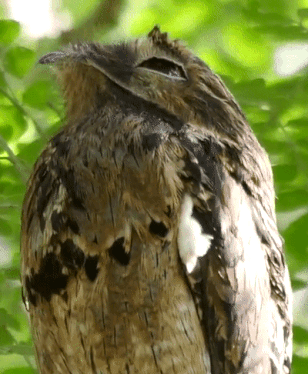
Propaganda under the cut:
Potoos are sometimes called “Poor-me-ones”, after the sound of their haunting calls.
While today potoos live only in Central and South America, fossil evidence indicates that they also inhabited Europe during the Paleogene.
The bright yellow, reflective eyes of potoos could be conspicuous to potential predators during the day, so they have unusual slits in their eyelids, which allow them to sense movement even when their eyes are closed.
Should a potoo sense potential danger it will adopt a "freeze" position with its feathers flattened, perfectly camouflaged against its chosen perch. The transition between perching and the freeze position is gradual and hardly perceptible to the observer.

(source)
If the freeze position is not affective, the potoo will then attempt to surprise and intimidate a predator by opening its eyes and beak wide while vocalizing, giving it a chance to fly out of reach (image 3).
#I love them but also they scare me so bad#a considerable effort to find photos that don’t look like bird body horror#animal polls#round 3#reptilia#Nyctibiiformes
71 notes
·
View notes
Text
nine people i want to get to know better
tagged by the lovely @effervescentyellow ! thank youuu <3
LAST SONG? - I've been listening to Foster the People's new album trying to decide if I like it (it's growing on me!), so rn Glitchzig is playing.
FAVORITE COLOR? - Periwinkle! or just like blue/purple lol
CURRENTLY WATCHING? - just recently finished A League of Their Own series, and still mourning getting to watch the Olympics constantly lol, so kind of in between shows rn!
LAST MOVIE? - Okay I'm super blanking on what the last movie I watched was lol. I remember the last one I saw in theaters was Challengers, which was ages ago, but still I'll just say that.
SWEET/SPICY/SAVORY? - I have a huuuuge sweet tooth so definitely that. I do love spicy too though!
RELATIONSHIP STATUS? - married to my beautiful amazing wife for about a year and a half now :') and celebrated our 5 year dating anniversary earlier this month!
CURRENT OBSESSIONS? - tbitb (writing The Cormorant is taking up so much of my brain space omg), aloto (specifically jess and lupe), the Olympics (women's sport climbing was my fav!!), Hana Vu's music, this new flavor of Ben and Jerry's ice cream I tried (salted caramel brownie), False Knees comics, Charli xcx brat, the birds that keep coming to our back patio to inspect our furniture and my wife's bike (lots of chickadees and tufted titmice!), youtube, the board game Wingspan
LAST THING YOU GOOGLED? - potoos because of a convo with @seasidesandstarscapes lolol (I was trying to remember if they were related to frogmouths and confirmed that they're both types of nightjars!)
tagging: don't have 9 people lol but uhh I'll tag @dogwooddiaries and @borealopelta !
11 notes
·
View notes
Note
Hey friend ! :D
I wanted to ask a silly question ! What is your favorite bird if you have one ? Mine are seagulls ! They're so silly I love them :)
Also ! My birthday passed and I got some books and a brand new tablet to draw and stuff I'm sooo happy :D
I want to talk more about this but idk if u want to listen so let me know if it interest you I like to ramble so... Yeah-
-🦔
My silly answer is potoos, frogmouths, and nightjars oh my! They have such derpy little faces and fleshy absurdly large mouths. My more serious answer is the chickadee. I have always loved them. Some of the smallest amongst the birds. Chicka-dee-dee-dee!
Happy Birthday! Sounds like you got some awesome gifts! I'm happy for you! I just discovered that I can draw using a dip pen and ink. A dip pen is like an old fashioned quill pen. It's fun!
Ramble all you want, I'm happy to listen!
4 notes
·
View notes
Note
Sounds like the finger situation sucks, so here are some funny looking birds to cheer you up.
Common nighthawk (Chordeiles minor)
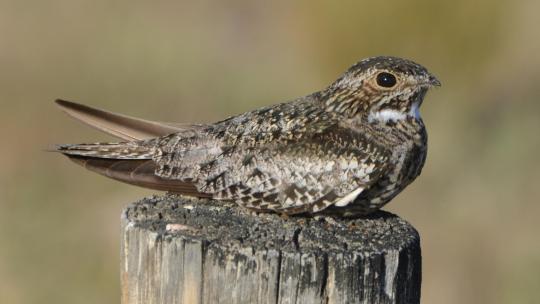
Eastern whip-poor-will (Antrostomus vociferus)

Frogmouth (Podargus strigoides)
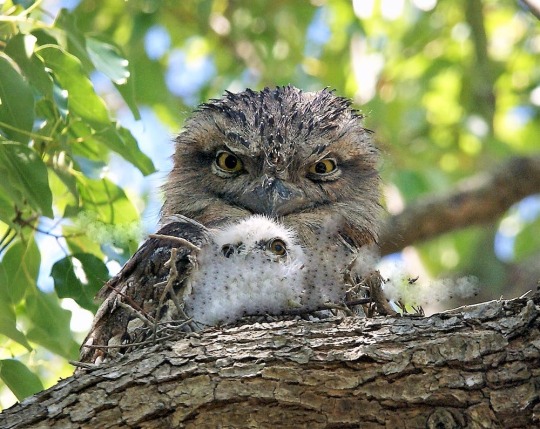
Common potoo (Nyctibius griseus)

Oh those are some creatures!!!! They’re all so neat looking, thank you for showing me them :D
That third one looks kinda like a cat XD
10 notes
·
View notes
Text
Palestine Sunbird
As usual ALL PROCEEDS will go to my Palestinian best friend to help his loved ones through this war and help his girlfriend afford to join him in America. He is the sweetest person in the world (and a truly brilliant scientist) and he deserves to be able to focus on grad school as best he can through this awful genocide without financial stress on top of the emotional toll. I just added a few new versions of my Palestine sunbird:




The keffiyeh is borrowed from my dove drawing:


This is what the real bird looks like:


The Palestine sunbird is a beautiful little passerine found around parts of the Middle East and Africa. They look somewhat like giant hummingbirds (though that is entirely convergent evolution, hummingbirds are actually in the same clade (Strisores) as potoos and frogmouths and stuff, which I find very surprising). These little guys were adopted as Palestine's national bird in 2015. My designs are available on shirts, stickers, mugs and more, here is the link to my collection (click on a design and scroll down to see more product options). Thank you to everyone who has helped so far!
#palestine#free palestine#gaza#free gaza#save palestine#gaza strip#colonialism#decolonization#فلسطين#jerusalem#social justice#human rights#palestine sunbird#sunbird#birdblr#birds#gazaunderattack#save gaza#ceasefire#redbubble
63 notes
·
View notes
Text
The Holghras

Week two of bestiaryposting met me with much less inspiration than the first—I've been a bit pressed for time and motivation, and the lack of concrete description in this entry didn't help. Nevertheless, I think I've got a decent Holghras despite not taking as much time on the artwork as I did for the Wutugald.
This is clearly some sort of ground-nesting bird, but other than that there's no information on its appearance. It reminded me of game birds—while I have no clue what the real deal is, I'd guess that's not far off the mark. I took a lot of inspiration for its appearance from the prairie chicken, but couldn't (and didn't want to) shake the image of it having a wide face like a frogmouth or potoo. I'll do my best to create a modernized description of this guy!
The Holghras
The Holghras (Fusoris invidia) is a game bird native to the prairies of North America. It stands at just under 20 inches tall at maturity, and typically weighs between five and seven pounds. Its appearance is squat with a large head and brown-and-grey barred feathers. Both males and females feature upturned tails with stray feathers to either side, "horns" on the sides of their heads, and distinctive yellow beaks and eyes. Male Holghras have bright red and yellow feathers on their necks, backs, and the undersides of their wings.
A Holghras's diet consists mainly of insects and other invertebrates. They will both dig in the dirt for grubs and worms and catch low-flying insects in their mouths. Holghras are also seen to eat seeds, berries, and the chicks and eggs of other Holghras.
Holghras are perhaps best known for their croaky "OL-gra!" mating call, which can be heard in their range throughout the mating season—which lasts from May to October. Often, Holghras will mate multiple times during this season, and lucky individuals will have several clutches of eggs a year.
Unfortunately, such instances are uncommon due to the tendency of the male Holghras to smash the eggs of the female in a bid to mate with her. Female Holghras will seldom leave their nests if they are incubating eggs, but as their mates show no fidelity, they must still hunt for themselves, and it is during this time that the male will approach her nest, destroy her eggs, and make mating displays once the female returns.
Once Holghras chicks are hatched, the mother has the freedom to carry her chicks with her, sheltering them beneath her wings as she walks around to hunt for insects. If she is ever to take off in flight to catch her prey, she must beware—a male Holghras might kill and cannibalize her chicks while they are not under her wings.
On occasion, a female Holghras will steal the eggs or chicks of another to use as decoys, leaving her own hidden. However, Holghras chicks imprint strongly on their birth mothers, and will leave a surrogate immediately upon seeing their true parent. The chicks must be quick, however, as there is a chance that the two mothers will fight, and one may end up killing and eating the other's chicks.
Holghras nests are built on the ground, at the bases of thick shrubs. The mother will roll her eggs, which come in clutches of two to four, under the shrub where a full-grown Holghras will find it difficult to reach. She will then sit as close to the eggs as possible to incubate them, covering them with twigs and dust when she must be absent. Once the chicks hatch, they will nestle themselves under the shrub if ever the mother cannot take them with her, burying themselves with leaves and clods of dirt if approached.
A mother Holghras has a strong desire to protect her chicks until such a point as they are able to fly and leave her nest. She will lure predators away by pretending to be injured and staggering away to a distance where they cannot track her back home once she drops the pretense and flies away. If she ever sights a male arriving to kill her eggs, she will move some distance away and pretend to have no eggs, mating with the male and raising the new clutch alongside her previous one.
8 notes
·
View notes